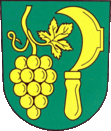Hlína
| Hlína | ||||
|---|---|---|---|---|
|
||||
| Basic data | ||||
| State : |
|
|||
| Region : | Jihomoravský kraj | |||
| District : | Brno-venkov | |||
| Area : | 834 ha | |||
| Geographic location : | 49 ° 7 ' N , 16 ° 26' E | |||
| Height: | 420 m nm | |||
| Residents : | 295 (Jan. 1, 2019) | |||
| Postal code : | 664 16 | |||
| License plate : | B. | |||
| traffic | ||||
| Street: | Moravské Bránice - Neslovice | |||
| Railway connection: | Hrušovany nad Jevišovkou – Brno | |||
| Next international airport : | Brno-Turany Airport | |||
| structure | ||||
| Status: | local community | |||
| Districts: | 1 | |||
| administration | ||||
| Mayor : | Miloš Dostalý (as of 2009) | |||
| Address: | Hlína 19 664 91 Ivančice |
|||
| Municipality number: | 583022 | |||
| Website : | www.obec-hlina.cz | |||
Hlína (German Hlina ) is a municipality in the Czech Republic . It is located four kilometers northeast of Ivančice and belongs to the Okres Brno-venkov .
geography
Hlína is located in the Hlínská vrchovina hills at the southern foot of the Hlinský Kopec (451 m). The village is on the edge of the Bobrava Nature Park. The Šatava rises to the north and the Martálka to the northwest. The Babí hora (351 m) rises to the southwest, the Bukovina (385 m) to the south and the Veselá hora (392 m) to the west. Two and a half kilometers east of the village runs the Hrušovany nad Jevišovkou – Brno railway line , the nearest railway station is Silůvky .
Neighboring towns are Špidleny, Tetčice and Omice in the north, Střelice and Radostice in the northeast, Prštice and Silůvky in the east, Mělčany and Dolní Kounice in the southeast, Moravské Bránice in the south, Ivančice in the southwest, Oslavany in the west and Padochov and Neslovice in the northwest.
history
Archaeological finds of stone axes and arrows show a settlement of the local corridors between the Paleolithic and Iron Age . In 1865, 1335 Czech and Moravian coins from the 11th century were unearthed in a field.
The first written mention of the place took place in 1208 in connection with the construction of the parish church of St. Kunigunde. It is believed that the parish was subordinate to the Rosa Coeli monastery. At Hlína, the medieval Hungarian route from Ivančice to Hungary crossed the cattle route from Hustopeče to Polná and the road from Znojmo to Brno, as well as another trade connection to Pavlov .
After the monastery was closed in the 16th century and the population became Protestant, the parish in Hlína also went out around 1590. From then on, the rectory served as a hunter's house. The church fell into disrepair. Hlína was subject to the Kounice rule; Ferdinand I and subsequently the Prince Dietrichstein belonged to the owners . After the Thirty Years' War, Hlína was parish in Kounice in 1656. From 1787 the village was attached to the locality in Neslovice . In 1793 the old church was demolished. The new building, erected 20 m northeast of it for 1828 guilders, was consecrated as a branch church on September 24, 1794.
After the abolition of patrimonial Hlína formed from 1850 a municipality in the district authority of Brno. In the 1860s, the Hrušovany nad Jevišovkou – Střelice railway was built east of the village . In 1921 the municipality was assigned to the Okres Brno-venkov. In 1938 the village consisted of 98 houses and had 400 inhabitants. In 1947 the municipality of Hlína had 384 inhabitants. Between 1948 and 1960 Hlína belonged to the Okres Rosice. After its cancellation, Hlína came back to the Okres Brno-venkov. On July 1, 1980, Hlína was incorporated together with Kratochvilka to Neslovice. In 1990 Hlína broke away from Neslovice and formed its own community. At that time there were 246 people in the village. In 2007 the observation tower was inaugurated.
Community structure
No districts have been identified for the municipality of Hlína. The settlement of Špidleny belongs to Hlína.
Attractions
- baroque church of St. Kunigunde, built in 1794 instead of a previous building from 1208. The church tower is 23 m high. The main altarpiece of the Kunigunde is a work by Josef Mayer from 1746.
- Rozhledna Vladimíra Menšíka lookout tower on Hlinský Kopec , the 22 m high structure inaugurated in April 2007 is named after the actor Vladimír Menšík .
- Statues of the Virgin Mary and St. Josef from 1760, at the church
- Cross on the church, erected in 1852
- Prayer column, at the wayside cross north of the village
- Bobrava Nature Park, east and north of the village

